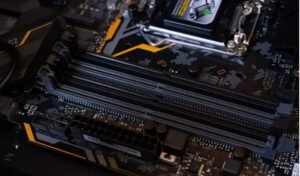Generative Music Modular
Generative music is an intriguing concept where music is created through algorithms and randomization, providing endless variations and possibilities. A generative music modular system takes this concept further by using modular synthesizers and software to create dynamic and evolving musical compositions.
Key Takeaways
- Generative music modular systems use algorithms and randomization to create dynamic and evolving musical compositions.
- Modular synthesizers and software play a crucial role in generating generative music.
- Generative music modular systems offer endless possibilities for unique and ever-changing musical compositions.
**Modular synthesizers** are electronic musical instruments that consist of individual modules, each responsible for a specific function such as generating sound, modifying sound, or controlling the overall system. These modules can be connected, rearranged, and patched together in various configurations, allowing for a high degree of experimentation and customization.
Generative music **software** plays a vital role in generative music modular systems. It provides the algorithms and logic needed to generate music based on predefined rules and parameters. This software can control and manipulate the different modules in the modular synthesizer, creating unique and evolving musical compositions.
**Randomization** is a key element in generative music modular systems. By introducing randomness into the music generation process, the system can create surprising and novel musical patterns. This element of unpredictability provides a sense of exploration and discovery, making generative music modular compositions truly unique.
One interesting aspect of generative music modular systems is their ability to **self-generate** music without human intervention. Once the initial parameters and rules are set, the system can continuously generate music that evolves over time. This autonomous nature allows for compositions that are not constrained by traditional musical structures and can provide a constant source of inspiration.
Modular Synthesizer Modules
| Module | Description |
|---|---|
| VCO (Voltage-Controlled Oscillator) | Generates the basic audio signals that form the foundation of the sound. |
| VCF (Voltage-Controlled Filter) | Shapes the timbre and character of the sound by filtering certain frequencies. |
| ADSR (Attack-Decay-Sustain-Release) | Controls the envelope of the sound, determining how it changes over time. |
Generative music modular systems enable the creation of **complex textures** and **layered compositions**. By combining multiple modules and configuring them in parallel or in series, musicians can create rich and intricate musical landscapes. The interplay between modules and the randomization algorithms can result in unexpected harmonies, rhythms, and sonic textures.
Benefits of Generative Music Modular Systems
- Endless musical possibilities: Generative music modular systems offer unlimited variations and combinations, making each composition unique.
- Constant source of inspiration: The autonomous nature of these systems allows for the continuous generation of new musical ideas.
- Exploration of new musical territories: Generative music modular systems encourage experimentation and can lead to the discovery of novel musical patterns and arrangements.
Generative Music Modular Software
| Software | Description |
|---|---|
| Max/MSP | A visual programming environment for music and multimedia, allowing users to create their own generative music systems. |
| SuperCollider | An audio programming language and environment that provides a platform for generative music creation. |
| VCV Rack | An open-source virtual modular synthesizer that offers a wide range of modules for generative music composition. |
With the advancement of technology, generative music modular systems continue to evolve and push the boundaries of traditional composition. These systems offer musicians and artists a new and exciting way to create music that is constantly changing and evolving.
Generative music modular systems have become a valuable tool for musicians, composers, and sound designers who seek to explore new sonic possibilities and break free from conventional musical structures. By harnessing the power of algorithms and modular synthesizers, they are able to create compositions that are unique, unpredictable, and truly captivating.

Common Misconceptions
Paragraph 1: Generative Music is Only for Experimental Musicians
One common misconception about generative music is that it is limited to experimental musicians or avant-garde composers. While it is true that generative music has been popular in experimental and electronic music genres, it is not exclusively for those artists. Generative music techniques can be used in various genres, including pop, rock, and classical music.
- Generative music can enhance the creative process for musicians in all genres.
- Using generative music techniques does not necessarily mean creating abstract or challenging music.
- Generative music can be an accessible tool for songwriters looking for new ideas or inspiration.
Paragraph 2: Generative Music is Just Random Noise
Another common misconception is that generative music is purely based on random noise or chaotic sounds. While there are generative music approaches that incorporate randomness, not all generative music is created this way. Generative music can be highly structured and controlled, using algorithms and rules to generate musical patterns and compositions.
- Generative music can produce intricate and sophisticated compositions.
- Generative music can be designed to follow specific musical rules and guidelines.
- Generative music can be an organized and intentional process, resulting in harmonious and melodic compositions.
Paragraph 3: Generative Music is Fully Automated and Removes Human Input
Some people wrongly assume that generative music is fully automated and eliminates the need for human input or creativity. While generative music employs algorithms and rules to generate musical output, it still requires human guidance and creative input to set the initial parameters and shape the final composition.
- Generative music is a collaboration between human creativity and technological algorithms.
- Human input is crucial in defining the boundaries and constraints of the generative system.
- Musicians can actively interact with the generative system to shape and influence the output in real-time.
Paragraph 4: Generative Music Lacks Emotional Connection and Expressiveness
Another misconception is that generative music lacks emotional depth and expressiveness, as it is created through algorithms and rules rather than human emotions. However, generative music can indeed convey strong emotional experiences, as the interaction between the generative system and the musician can create unexpected and evocative musical outcomes.
- Generative music can evoke a wide range of emotions, just like music created through traditional methods.
- Musicians can infuse their personal emotions and intentions into the generative system, making it a channel for self-expression.
- Generative music can surprise and inspire musicians, leading to emotionally resonant compositions.
Paragraph 5: Generative Music is Too Complex and Difficult to Understand
Lastly, some people have the misconception that generative music is too complex and difficult to understand for non-experts or casual listeners. While there are complex generative music systems, there are also simpler and more accessible approaches that can be appreciated by a broader audience.
- Generative music can be designed for accessibility, allowing anyone to engage with and appreciate the composition.
- Listeners can enjoy the unpredictability and unique elements of generative music, even without understanding the technical details.
- The complexity of generative music can be explored and appreciated at different levels, from casual enjoyment to in-depth analysis.

Introduction
Generative music is a type of music that is created by using a system of rules or algorithms to generate new musical content. One popular method of creating generative music is through modular synthesis, which involves using modules to manipulate sound and create unique compositions. In this article, we will explore various aspects of generative music and modular synthesis through a series of informative tables.
Table 1: Benefits of Generative Music
Generative music offers various benefits that make it a fascinating field. This table highlights three key advantages:
| Benefit | Description |
|---|---|
| Creativity | Offers endless possibilities for musical expression. |
| Unique Compositions | Produces music that cannot be replicated exactly. |
| Continuous Evolution | Generates music that evolves over time, creating dynamic listening experiences. |
Table 2: Types of Modules Used in Modular Synthesis
Modular synthesis relies on different modules to shape and manipulate sound. This table explores three common types:
| Module Type | Description |
|---|---|
| Oscillator | Generates raw audio signals with varying waveforms. |
| Filter | Alters the frequency content of audio signals. |
| Envelope Generator | Controls parameters over time, such as volume and filter cutoff. |
Table 3: Influential Generative Musicians
Generative music has been shaped by innovative artists who have made significant contributions to the field. The following musicians have had a profound impact:
| Musician | Notable Work |
|---|---|
| Brian Eno | “Music for Airports” – A pioneering ambient generative music album. |
| Iannis Xenakis | “Gendy3” – Incorporates probabilities and randomness into composition. |
| Aphex Twin | “Selected Ambient Works Volume II” – Uses generative processes to create ethereal soundscapes. |
Table 4: Famous Modular Synthesizers
Modular synthesizers come in various shapes and forms. Here are three iconic models:
| Synthesizer | Description |
|---|---|
| Moog Modular Synthesizer | One of the first commercially available modular systems, known for its warm analog sound. |
| Buchla Music Easel | A portable and expressive modular synth famous for its touch-sensitive keyboard. |
| Make Noise Shared System | A versatile and comprehensive modular synth designed for experimentation. |
Table 5: Applications of Generative Music
Generative music finds applications in various creative and practical domains. This table explores three diverse areas:
| Application | Description |
|---|---|
| Ambient Soundscapes | Used to create atmospheric music for meditation, relaxation, and immersive experiences. |
| Video Games | Generative music adapts to gameplay, enhancing the gaming experience by providing dynamic audio. |
| Sound Installations | Installed in art galleries and public spaces to create unique sonic environments. |
Table 6: Generative Music Algorithms
Generative music algorithms form the foundation of many compositions. This table covers three popular algorithms:
| Algorithm | Description |
|---|---|
| Markov Chains | Uses probability theory to generate new musical sequences based on existing patterns. |
| Cellular Automata | Applies a set of rules to a grid of cells to create evolving musical patterns. |
| Genetic Algorithms | Simulates biological evolution by using selection and mutation to generate new musical phrases. |
Table 7: Influences on Generative Music
Generative music draws inspiration from diverse fields and concepts. This table highlights three notable influences:
| Influence | Description |
|---|---|
| Artificial Intelligence | AI techniques inform generative music processes, allowing for complex and adaptive compositions. |
| Fractals | Mathematical fractal patterns inspire generative music compositions with self-similarity. |
| Stochastic Processes | Probability theory and random processes contribute to creating unexpected musical outcomes. |
Table 8: Notable Generative Music Albums
Over the years, several albums have pushed the boundaries of generative music. Here are three noteworthy examples:
| Album | Artist |
|---|---|
| “Discreet Music” | Brian Eno |
| “Music for 18 Musicians” | Steve Reich |
| “Reflection” | Max Richter |
Table 9: Challenges in Generative Music
Despite its many benefits, generative music also faces various challenges. This table sheds light on three key obstacles:
| Challenge | Description |
|---|---|
| Humanization | Creating generative music that feels organic and human-like is a complex task. |
| Longevity | Maintaining interest in generative music compositions over extended durations can be challenging. |
| Algorithmic Complexity | Developing sophisticated algorithms that generate high-quality musical output is a significant undertaking. |
Table 10: Future Trends in Generative Music
The field of generative music continues to evolve, paving the way for new possibilities. This table explores three potential future trends:
| Trend | Description |
|---|---|
| Virtual Reality Integration | Combining generative music with virtual reality to create immersive audiovisual experiences. |
| Machine Learning Enhancement | Utilizing machine learning algorithms to enhance the capabilities of generative music systems. |
| Social Collaboration | Enabling musicians to collaborate on generative music in real-time using networked systems. |
Conclusion
Generative music and modular synthesis offer unique approaches to musical composition, where randomness, algorithms, and evolving soundscapes converge. From the benefits of generative music to the applications and influences, this article aimed to provide a comprehensive overview. As the future trends suggest, the realm of generative music continues to expand, promising exciting possibilities for both artists and listeners alike.
Frequently Asked Questions
Generative Music Modular




